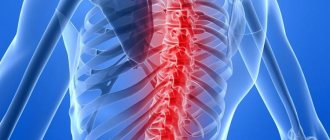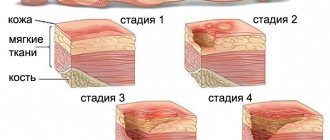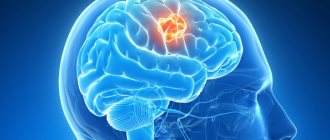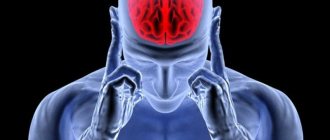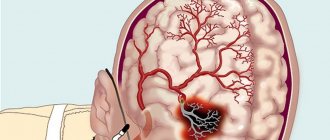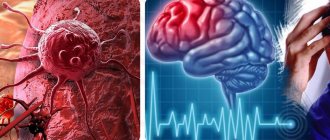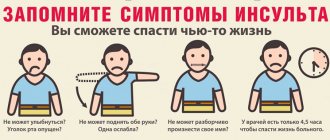Spinal ischemic stroke is an acute violation of the spinal circulation due to compression, blockage or other damage to the spinal artery with the subsequent development of softening and the formation of a cavity in the area where new blood vessels are formed. Ischemic stroke of the spinal cord affects women more often. This is a rather rare pathology, since blockage of a single artery of the spinal cord in most cases does not lead to the development of a spinal stroke due to the severity of collateral circulation and the many anastomoses between the arteries. The Yusupov Hospital has created all the conditions for the successful treatment of patients with spinal stroke.
The neurology clinic is equipped with modern equipment allowing doctors and rehabilitation specialists to use innovative treatment methods. Neurologists, after a comprehensive examination of the patient, draw up individual treatment regimens with the most effective drugs. Patients with spinal stroke, regardless of severity, are admitted to the neurology clinic around the clock.
Causes
Ischemia is a cessation of blood flow due to complete or partial blockage of blood vessels. Cerebral and spinal ischemia have a similar mechanism of development.
Disturbance of the spinal blood supply occurs for the following reasons:
- Vascular lesions of the spinal cord (congenital vascular malformations, coarctation of the aorta, atherosclerosis, thromboembolism).
- Compression of spinal vessels from the outside (compression of herniated intervertebral discs, enlarged lymph nodes, tumor, fragments of an injured vertebra, pregnant uterus).
- Iatrogenic causes, that is, caused by medical actions (paravertebral blockades, epidural anesthesia, rough manual therapy techniques).
Treatment and recovery for spinal stroke
To choose an adequate treatment tactic, the doctor must identify the nature of the pathological process and its exact location. Surgery is indicated if the cause of the blood flow disturbance is a neoplasm, vascular anomaly or intervertebral hernia.
For spinal cord infarction, drugs from the group of antiplatelet agents and anticoagulants (Heparin, Curantil), as well as drugs that reduce portal pressure (Instenon, Cavinton, etc.) are indicated. The patient is prescribed drugs to improve venous tone (Eskuzan and Troxevasin), angioprotective drugs (Troxerutin or Ascorutin) and neuroprotectors (Nootropil, Actovegin, etc.)
In addition, Reopoliglucin and fresh frozen plasma are infused intravenously. To combat swelling, diuretics (Lasix) are needed, and Neuromidin is indicated to improve impulse conduction. The patient should receive NSAIDs - for example, Ibuprofen or Diclofenac. Baclofen and Mydocalm help reduce pathologically increased muscle tone. The introduction of B vitamins is also indicated.
If the blood flow disorder is hemorrhagic in nature, the patient needs means to strengthen the vascular walls (Contrical, Aminocaproic acid), which help prevent relapse. Verapamil or Nimotop helps relieve vasospasm. Neuro- and angioprotectors are also needed.
If conservative methods of treating hemorrhagic stroke do not produce positive results, and also if there are injuries or tumors of the spinal cord, neurosurgical intervention is required.
With a spinal stroke with paraparesis of the lower extremities, recovery is a long and very labor-intensive process.
Patients are in dire need of psychosocial adaptation. They need the help of a qualified psychotherapist to combat depression. If indicated, the doctor may prescribe drug therapy (drugs from the antidepressant group).
During the period of treatment and recovery for spinal stroke, kinesiotherapy is of great importance. Passive gymnastics is recommended for bedridden patients, and when restoring motor functions, specially designed sets of static and dynamic exercises are used.
Acupuncture and general massage sessions help speed up the recovery process.
Electrical stimulation, as well as physiotherapeutic procedures such as ozokerite and paraffin applications, electro- and phonophoresis, will help to cope with muscle weakness after a spinal stroke.
The text was checked by expert doctors: Head of the socio-psychological service of the Alkoklinik MC, psychologist Yu.P. Baranova, L.A. Serova, a psychiatrist-narcologist.
CAN'T FIND THE ANSWER?
Consult a specialist
Or call: +7 (495) 798-30-80
Call! We work around the clock!
Clinical manifestations
Spinal ischemia or ischemic spinal stroke occurs equally frequently in men and women aged 40 years and older.
The clinical picture of ischemic spinal cord stroke is varied. Depending on the level at which the stroke occurred, certain symptoms will appear. For example, a circulatory disorder in the upper cervical level causes a sharp disorder of movements in the arms and legs, and respiratory failure with symptoms of spinal shock may develop. Below the level of ischemia, hyposthesia also occurs, loss of all types of sensitivity: temperature, tactile, pain.
When the lesion is localized in the cervical region, flaccid paralysis of the arms and spastic paresis of the legs develop.
The lumbar region of the spinal cord is most often affected. Ischemia of this zone leads to paralysis of the legs with dysfunction of the pelvic organs.
With any form of spinal stroke, bedsores and trophic disorders develop.
By analyzing the symptoms, it is possible to determine which vascular basin has been damaged, or which artery has lost patency.
The rate of development of the listed symptoms is different; the pathological process can develop suddenly or gradually over the course of a day. Sometimes an acute disorder of spinal circulation is preceded by warning symptoms: pain in the spine, intermittent claudication, transient paralysis.
During the course of the disease, neurologists distinguish the following stages:
- period of harbingers;
- stage of acute stroke;
- symptom regression stage;
- stage of residual (residual) phenomena.
Diagnosis of ischemic spinal cord stroke
At the time of admission of a patient with suspected ischemic stroke of the spinal cord, neurologists at the Yusupov Hospital conduct a thorough neurological examination and check hemodynamics (blood movement through the vessels). Doctors then order the following laboratory tests:
- general blood analysis;
- erythrocyte sedimentation rate;
- blood biochemistry (sugar, lipids and cholesterol, creatinine, protein fractions);
- blood electrolytes;
- coagulogram.
The following instrumental studies are carried out using modern equipment from leading European, American and Japanese companies:
- magnetic resonance imaging of the spinal cord;
- CT angiography or MRI angiography;
- duplex scanning of brachiocephalic vessels;
- ECHO-KG;
- determination of cells, glucose and protein levels, oligoclonal antibodies to the herpes virus in cerebrospinal fluid obtained by spinal puncture;
- electrocardiography;
- X-ray of the lungs.
At the Yusupov Hospital, doctors first perform magnetic resonance imaging on patients with spinal stroke. Computed tomography is necessary to determine the location of the ischemic focus and exclude space-occupying formations of the spinal cord. It is used in cases where magnetic resonance imaging is not possible. Diffusion-weighted MRI is considered more sensitive in diagnosing spinal ischemic stroke during the first hours of spinal cord infarction. If indicated, angiography of the spinal cord artery is performed.
Treatment
Treatment of ischemic spinal stroke is carried out taking into account the causes of the pathology. The following measures are common to all types of circulatory disorders:
- Hospitalization in a specialized neurology department, bed rest;
- Prevention of bedsores and trophic disorders;
- Regular emptying of the bladder;
- Maintaining basic life functions;
- Therapeutic exercise, massage of affected limbs.
Drug therapy for spinal cord ischemia is similar to the treatment for cerebral stroke:
- Neuroprotectors - Gliatilin, Cerakson, Actovegin, Mexidol.
- Drugs that improve blood supply to the spinal cord - Cavinton, Sermion, Instenon.
- Medicines to thin the blood and prevent blood clots - Trental, Curantil.
- Anticoagulants – Fraxiparin, Heparin.
- Vitamins, antioxidants.
If there is no effect from conservative therapy or if the cause of the stroke is compression by a tumor or hernia, neurosurgical intervention cannot be avoided.
Acute spinal circulatory disorders are easier to prevent than to cure. Prevention of the disease consists of timely treatment of chronic diseases (atherosclerosis, arterial hypertension), osteochondrosis, and spinal injuries.
Symptoms of a spinal stroke
At the stage of the so-called “precursors” the following are noted:
- numbness in the limbs;
- transient muscle weakness;
- tingling or burning sensation.
Clinical manifestations of ischemic stroke:
- rapidly developing muscle weakness in the arms or legs;
- loss of sensation;
- disturbances in the functional activity of the pelvic organs.
Signs of hemorrhagic form:
- intense pain of a girdle nature;
- paralysis of one or more limbs (usually flaccid, peripheral);
- loss of sensitivity.
With extensive hemorrhages in the thickness of the medulla, the development of tetraparesis cannot be ruled out.
Reverse development
The stage of reverse development of symptoms begins a month after the onset of the disease. This stage is characterized by a fragmented restoration of blood supply in the area that was damaged. Recovery occurs due to the flow of blood into the arteries from other large vessels. There is also a restoration of the functions of neurons that remained as intact as possible at the site of the stroke.
As for the reverse development, it is characterized by a slow decrease in sensitivity, the return of some movements inherent in the limbs and the resumption of the work of the pelvic organs. The speed of this process, as well as the extent of restoration of lost function, will depend on the location of the ischemic stroke in the spinal cord.
Spinal circulatory disorders
Vascular damage to the spinal cord can be caused by a number of factors.
Pathology of the aorta may be a consequence of its atherosclerosis or coarctation. Atherosclerosis of the aorta is characterized by slowly developing signs of insufficient blood supply to the lower extremities (Leriche syndrome, intermittent claudication, ischemic neuropathy of the sciatic nerve).
With coarctation of the aorta, signs of arterial cerebral hypertension, segmental diapedetic hemorrhages, occasionally Brown-Séquard syndrome, and ischemic phenomena in the spinal cord below the level of stenosis are observed.
An anomaly of the spinal vessels (aneurysm, varicose veins) is manifested by sharp radicular pain, focal spinal symptoms, varying depending on the level of the lesion. It occurs with remissions and exacerbations and is progressive in nature.
Osteochondrosis of intervertebral discs.
Acute ischemic spinal circulatory disorders.
More often they occur in the lower parts of the spinal cord, less often in the cervical cord.
Provoking factors are minor injury, physical stress, sudden movement, drinking alcohol, cooling. They develop in a stroke-like manner within 1 hour to 24 hours, sometimes at night during sleep. Clinical manifestations depend on the level of damage. Movement disorders are combined with sensory ones (segmental in the affected area, below – conduction type). Pathogenetically, they are associated with compression or irritation of the anterior spinal or radiculomedullary artery (usually the artery of Adamkiewicz), a degenerative disc or osteophyte.
Spinal cord ischemia can occur in the form of transient circulatory disorders or as cerebral infarctions. In the acute period (3–5 days), body temperature and ESR may increase with normal leukocytosis. The amount of protein in the cerebrospinal fluid increases, where red blood cells and neutrophils can be found, which is associated with microhemorrhages in the ischemic zone. With mild degrees of damage, regression of symptoms begins a week or a little later (flaccid paralysis turns into spastic paralysis, the level and degree of sensory disorders decrease, sphincter function is restored). With extensive infarctions in the spinal cord, the outcome is usually fatal: in the short term - as a result of the addition of cardiac and respiratory disorders, in the long term - from pneumonia, urogenous infection, intoxication due to bedsores and sepsis.
Slowly progressive spinal ischemia (dyscirculatory ischemic myelopathy or discogenic myelopathy). Etiology and pathogenesis: 1) compression factor - vessels are compressed faster than brain tissue; secondary adhesive membrane process at the level of the disc and beyond; 2) changes in the spinal cord vessels themselves due to proliferation of the intima and adventitia with subsequent secondary disorders of the perimedullary and collateral circulation. It occurs more often in men aged 40–60 years. Provoking factors are injuries, heavy physical labor, sudden movements, atherosclerosis, intercurrent infections and surgery. It is localized more often in the cervical, less often in the lumbar spinal cord. The course is long-term, can stabilize over 5–10 years, sometimes progressing.
Clinical manifestations. Main syndromes: amyotrophic (severe muscular atrophy of the proximal limbs, sensory disorders); spastic-atrophic (weakness and atrophy of one of the limbs with a transition to the opposite side with a gradual increase in atrophy in the arms and spastic phenomena in the legs, sometimes with bulbar syndrome, sensory disorders are very weak, segmental type, radicular pain is often noted, in the late stage - impaired sphincter function); spastic (begins with numbness and awkwardness in the arms and legs, pain in the joints with the subsequent development of spastic tetraparesis, sensory disorders increase in the caudal direction, in the later stages - dysfunction of the pelvic organs).
All forms of myelopathies are characterized by a predominance of motor disorders over sensory ones. There is no parallelism between the intensity of the ischemic process and the degree of dystrophic changes in the spine. These conditions should be differentiated from other vascular diseases of the spinal cord, tumors, amyotrophic lateral sclerosis, syringomyelia, myelitis, multiple sclerosis, and hereditary diseases.
Spinal circulation disorders of the hemorrhagic type.
Clinical manifestations. The following clinical forms are distinguished.
1. Hematomyelia (Brown-Séquard syndrome, syringomyelic Minor syndrome, anterior horn syndrome).
2. Hematorachis , which often occurs with rupture of an arteriovenous aneurysm or spinal injuries. There is a strong pain radicular syndrome with irradiation in all directions, occurring suddenly; There are often dagger-like girdling pains along the spine, headache, nausea, vomiting, slight stupor, lethargy. Kernig's symptom is determined, often in combination with Lasegue's pain symptom; The rigidity of the neck muscles recedes into the background. Focal spinal symptoms can appear at any time of hemorrhage and are manifested by signs of spinal cord compression of varying degrees of severity.
3. Epidural hematoma (usually rupture of a vascular-spinal malformation), characterized by sharp local pain in the spine, the addition of radicular pain, and slowly increasing symptoms of spinal cord compression.
